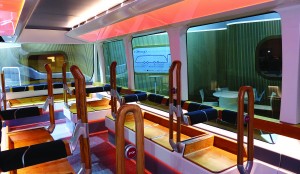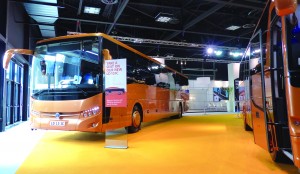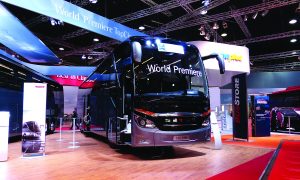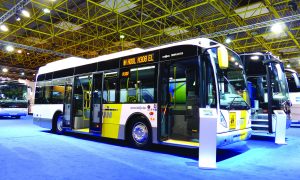
By Doug Jack
Luc Glorieux founded the first exhibition exclusively for buses and coaches in the small west-Belgium city of Kortrijk in 1971. Coaches predominated, but there were some tourism booths.
Held every two years in October, Busworld Kortrijk has grown enormously with the demand for exhibition space from bus and coachbuilders, vendors and suppliers eventually driving out the tourist booths.
This year, Busworld completely filled the Kortrijk Xpo exhibition center with 380 exhibitors from 30 countries.
Euro 6 engine emission limits come into force in January, so there were many new coaches with the latest generation engines in Busworld. The new coaches are all considerably quieter and there is strong evidence of significant savings in fuel consumption.
The launch of the new Setra TopClass 500 caught everyone’s eye. Still unmistakably a Setra, a number of styling features continue from the previous generation, including the distinctive La Linea styling bar over the first window on each side. However, there have been many subtle improvements to make the TopClass even more luxurious and functional at the highest level.

Setra promotes its new ComfortClass 500 series to a slightly lower and higher volume segment of the market. Introduced last year, it won the coveted “International Coach of the Year 2014” award following tests by an international jury of 19 trade journalists (each from a different European country).
Setra confirmed that versions of both the TopClass 500 and ComfortClass 500 will be available for the North American market.
Two years ago, Van Hool launched its new TX range of coaches at Busworld Kortrijk. Company CEO Filip Van Hool said that more than 800 had been delivered and that the new TX range was fully ready for Euro 6, with engines supplied by Paccar DAF.
He noted that the TX has been engineered for the North American market and that the factory in Macedonia had completed and delivered the first lower cost CX Commuter coach to Belgium, only 12 months after the ground-breaking ceremony. He was delighted to report that customers in North America had already placed orders for 125 TX45 and 600 CX45 coaches by the time of Busworld.


Busworld is often a venue for the latest trends in the industry. Manufacturers seem to be coming from a number of different directions, but all with the objective of reaching zero emission transport in urban centers. This year, there were at least 15 all-electric buses scattered around the exhibition.
There seems to be a consensus that the Chinese have taken a lead in types of batteries and battery control systems. Companies like BYD are promoting vehicles that have a range of 150 miles on a full charge in typical urban conditions.
Many argue that nearly two tons of batteries restrict the passenger carrying capacity. The battery power is not just to move a bus along its route; it also provides power for heating, air conditioning, lighting, doors and systems like power steering.
The second option is to have a bus with fewer batteries that can depart from a depot fully charged and take fast charging regularly at the end of each route or at busy stops. The recharging systems are either an overhead gantry above the vehicle, or a system on or under the surface of a street. Smaller batteries save weight and cost, and they give increased passenger capacity.
There was a lot of interest in fast recharging at Busworld with Alex Naef, the chief executive of Hess (the Swiss bus builder) saying that VDV — the German equivalent of APTA — is working on an industry standard.
Volvo is coming from a slightly different direction by now offering the option of plug-in technology to give a fast boost to the batteries at each end of the route. In Volvo’s view, the principal objective is to achieve all-electric operation in city centers. The latest Euro 6 engines are so clean that hybrid operation in the suburbs is quite acceptable.
The new Ellisup concept vehicle, developed by Iveco Bus and a number of French partners, was the most stunning and innovative electric bus in the exhibition. Four Michelin electric hub motors drive four of the eight small Michelin wheels and tires. A combination of super capacitors and batteries capture electrical energy with capabilities for fast charging.
The external styling with deep windows is dramatic with plenty of French flair. With low backless seats and bright colors, the interior resembles a trendy café. The small wheels and flat floor front to rear create much more space inside.
I question whether it is practical to have city buses where so many passengers need to stand, especially at peak periods. The objective must be to persuade new customers to leave their cars at home and take the bus to work. When did anyone last see someone standing in a car?

Van Hool presented an all-electric version of its A308 midibus, which can use either inductive or conductive charging systems. The first three will enter service next spring in the Belgian city of Bruges.
BYD of China showed a 40-foot all-electric bus built to a Northern European winter specification, with double-glazing and additional heating. BYD has taken orders for nearly 100 all-electric buses from various European countries. BYD said that when it reaches 100, it will make a decision on establishing a European assembly plant.
It is rare to see a completely new manufacturer at an exhibition, but Vectia was one such company at Kortrijk. This is a new partnership between two Spanish companies, namely Castrosua, the bus bodybuilder, and CAF Power and Automisation, a train and tram builder. Vectia has taken over responsibility for building the Castrosua hybrid range and can offer either a CNG or diesel engine for thermal power.
There were various claims and counter claims about all-electric vehicles. Depending on the number of batteries fitted, the price could be up to twice that of a standard diesel bus. On the other hand, the price of electricity is far lower in Europe compared with the price of diesel.
Manufacturers were typically quoting a payback period of five to eight years. Of course, the emission argument only holds water if the electricity is by hydro, nuclear or other fossil-free means.
There is also considerable demand in Europe for minibuses and coaches, seating 10 to 20 passengers. Most are conversions of popular high-volume panel vans, mainly Mercedes-Benz and Iveco, but there are some with coach-built bodywork mounted on chassis. Several Turkish companies specialize in very highly customized vehicles with large luxurious reclining seats, usually laid out in club-form around tables.
Well represented in Busworld, the Turkish manufacturers are the subject of my next International Report.
Doug Jack is with Transport Resources in the United Kingdom.
